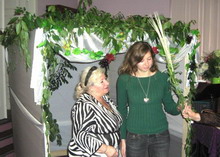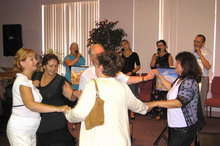Sukkot, the Feast of Tabernacles September 27 (at sundown) - October 4, 2015
Sukkot is a traditional Jewish Holiday celebrated on the 15th day of the month of Tishrei (late September to late October). It is the last of the Shalosh R'galim (three biblical pilgrimage festivals), when it was traditional for Jews to visit the Temple in Jerusalem.
 Sukkot was agricultural in origin. "The Feast of Ingathering,"from its ceremonies and occasion of its celebration: "At the end of the year when you gather in your labors out of the field" (Ex. 23:16); "after you have gathered in from your threshing-floor and from your winepress" (Deut. 16:13). It was a thanksgiving for the fruit harvest. Coming as it did at the completion of the harvest, Sukkot was regarded as a general thanksgiving for the bounty of nature in the year that had passed.
Sukkot was agricultural in origin. "The Feast of Ingathering,"from its ceremonies and occasion of its celebration: "At the end of the year when you gather in your labors out of the field" (Ex. 23:16); "after you have gathered in from your threshing-floor and from your winepress" (Deut. 16:13). It was a thanksgiving for the fruit harvest. Coming as it did at the completion of the harvest, Sukkot was regarded as a general thanksgiving for the bounty of nature in the year that had passed.
The word Sukkot is the plural of the Hebrew word sukkah, meaning booth or hut. The sukkah is reminiscent of the type of fragile dwellings in which the ancient Israelites dwelt during their 40 years of wandering in the desert after their Exodus from Egypt.
Simchat Torah, Rejoicing in the Law, October 4, 2015
 Simchat Torah, Hebrew for "rejoicing in the Law", celebrates the completion of the annual reading of the Torah. Simchat Torah is a joyous festival, in which we affirm our view of the Torah as a tree of life and demonstrate a living example of never-ending, lifelong study.Torah scrolls are taken from the ark and carried or danced around the synagogue seven times. During the Torah service, the concluding section of Deuteronomy is read, and immediately following, the opening section of Genesis is read.
Simchat Torah, Hebrew for "rejoicing in the Law", celebrates the completion of the annual reading of the Torah. Simchat Torah is a joyous festival, in which we affirm our view of the Torah as a tree of life and demonstrate a living example of never-ending, lifelong study.Torah scrolls are taken from the ark and carried or danced around the synagogue seven times. During the Torah service, the concluding section of Deuteronomy is read, and immediately following, the opening section of Genesis is read.
Chanukah, the Festival of Light, December 6, 2015
Chanukkah, the Jewish festival of rededication, also known as the festival of lights, is an eight day festival beginning on the 25th day of the Jewish month of Kislev.
 Chanukkah is probably one of the best known Jewish holidays, not because of any great religious significance, but because of its proximity to Christmas. Many non-Jews (and even many assimilated Jews!) think of this holiday as the Jewish Christmas, adopting many of the Christmas customs, such as elaborate gift-giving and decoration. It is bitterly ironic that this holiday, which has its roots in a revolution against assimilation and the suppression of Jewish religion, has become the most assimilated, secular holiday on our calendar.
Chanukkah is probably one of the best known Jewish holidays, not because of any great religious significance, but because of its proximity to Christmas. Many non-Jews (and even many assimilated Jews!) think of this holiday as the Jewish Christmas, adopting many of the Christmas customs, such as elaborate gift-giving and decoration. It is bitterly ironic that this holiday, which has its roots in a revolution against assimilation and the suppression of Jewish religion, has become the most assimilated, secular holiday on our calendar.
The story of Chanukkah begins in the reign of Alexander the Great. Alexander conquered Syria, Egypt and Palestine, but allowed the lands under his control to continue observing their own religions and retain a certain degree of autonomy.
More than a century later, a successor of Alexander, Antiochus IV was in control of the region. He began to oppress the Jews severely, placing a Hellenistic priest in the Temple, massacring Jews, prohibiting the practice of the Jewish religion, and desecrating the Temple by requiring the sacrifice of pigs on the altar. Two groups opposed Antiochus: a nationalistic group led by Mattathias the Hasmonean and his son Judah Maccabee, and a religious traditionalist group known as the Chasidim. They joined forces in a revolt against oppression by the Seleucid Greek government. The revolution succeeded and the Temple was rededicated.
According to tradition, at the time of the rededication, there was very little oil left that had not been defiled by the Greeks. Oil was needed for the menorah in the Temple, which was supposed to burn throughout the night every night. There was only enough oil to burn for one day, yet miraculously, it burned for eight days, the time needed to prepare a fresh supply of oil for the menorah. An eight day festival was declared to commemorate this miracle.
Shavu'ot, The Festival of the First Fruits, May 23, 2015
Shavu'ot, the Festival of Weeks, is the second of the three major festivals with both historical and agricultural significance (the other two are Passover and Sukkot). Agriculturally, it commemorates the time when the first fruits were harvested and brought to the Temple, and is known as Hag ha-Bikkurim (the Festival of the First Fruits). Historically, it celebrates the giving of the Torah at Mount Sinai, and is also known as Hag Matan Torateinu (the Festival of the Giving of Our Torah).
The period from Passover to Shavu'ot is a time of great anticipation. We count each of the days from the second day of Passover to the day before Shavu'ot, 49 days or 7 full weeks, hence the name of the festival.
The counting reminds us of the important connection between Passover and Shavu'ot: Passover freed us physically from bondage, but the giving of the Torah on Shavu'ot redeemed us spiritually from our bondage to idolatry and immorality. Shavu'ot is also known as Pentecost, because it falls on the 50th day; however, Shavu'ot has no particular similarity to the Christian holiday of Pentecost, which occurs 50 days after their Spring holiday.
It is noteworthy that the holiday is called the time of the giving of the Torah, rather than the time of the receiving of the Torah. The sages point out that we are constantly in the process of receiving the Torah, that we receive it every day, but it was first given at this time. Thus it is the giving, not the receiving, that makes this holiday significant.

